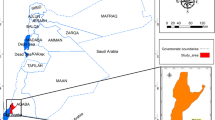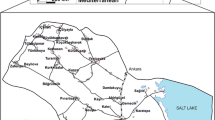Abstract
Land reform is identified as a key tool in fostering development in South Africa. Twenty years after the advent of democracy in South Africa, the land question remains a critical issue for policy makers. Several frameworks have been put in place by the government to identify land that is strategically located for land reform. However, many of these frameworks are not well aligned and not objective in defining strategically located land for land reform and often lead to unsustainable land use management practices. This has hampered the government’s land reform initiative in promoting agricultural land reform and food security. Accordingly, there is a need to develop a decision support tool that facilitates the identification of strategically located land for land reform. This study proposes the use of geographic information systems (GIS) and multi-criteria decision analysis (MCDA) to develop a strategically located land index (SLLI) to identify land suitable for agricultural land reform. Participatory workshops and the group analytical hierarchy process were utilised to identify and weigh criteria used in computing the SLLI. The results indicate that land that is suitable for agricultural land reform is scarce, and there are also competing needs on the highly suitable land for agriculture. The study demonstrates that GIS and MCDA are invaluable tools in facilitating evidence-based decision-making for land reform and sustainable land use management practices. The SLLI is not the panacea to land identification; there is also need to appreciate the contested nature of land in South Africa.









Similar content being viewed by others
Notes
Academic experts in GIS; professionals such as agronomists, development economists, crop specialists, livestock specialists, town planners, GIS professionals, environmentalists, agricultural experts, economists from various government departments together with civil society.
References
Ahamed, T. N., Rao, K. G., & Murthy, J. (2000). GIS-based fuzzy membership model for crop-land suitability analysis. Agricultural Systems, 63(2), 75–95. doi:10.1016/S0308-521X(99)00036-0.
Akıncı, H., Özalp, A. Y., & Turgut, B. (2013). Agricultural land use suitability analysis using GIS and AHP technique. Computers and Electronics in Agriculture, 97, 71–82. doi:10.1016/j.compag.2013.07.006.
Anwarzai, M. A., & Nagasaka, K. (2017). Utility-scale implementable potential of wind and solar energies for Afghanistan using GIS multi-criteria decision analysis. Renewable and Sustainable Energy Reviews, 71, 150–160. doi:10.1016/j.rser.2016.12.048.
Bradstock, A. (2006). Land reform and livelihoods in South Africa’s Northern Cape province. Land Use Policy, 23(3), 247–259. doi:10.1016/j.landusepol.2005.01.002.
Centre for Development and Enterprise (CDE). (2008). Land reform in South Africa: Getting back on track. Johannesburg: CDE.
Çetinkaya, C., Özceylan, E., Erbaş, M., & Kabak, M. (2016). GIS-based fuzzy MCDA approach for siting refugee camp: A case study for southeastern Turkey. International Journal of Disaster Risk Reduction, 18, 218–231. doi:10.1016/j.ijdrr.2016.07.004.
Dong, Q., & Cooper, O. (2016). A peer-to-peer dynamic adaptive consensus-reaching model for the group AHP decision-making. European Journal of Operational Research, 250(2), 521–530.
Elsheikh, R., Mohamed Shariff, A. R. B., Amiri, F., Ahmad, N. B., Balasundram, S. K., & Soom, M. A. M. (2013). agriculture land suitability evaluator (ALSE): A decision and planning support tool for tropical and subtropical crops. Computers and Electronics in Agriculture, 93, 98–110. doi:10.1016/j.compag.2013.02.003.
Fanon, F. (1963). The wretched of the earth. New York: Grove Press.
Farrow, A., & Winograd, M. (2001). Land use modelling at the regional scale: an input into rural sustainability indicators in Central America. Agriculture, Ecosystems & Environment, 85, 249–269.
Feizizadeh, B., & Blaschke, T. (2012). Thermal remote sensing for examining the relationship between urban Land surface Temperature and land use/cover in Tabriz city, Iran. Paper presented at the Geoscience and Remote Sensing Symposium (IGARSS), 2012 IEEE International.
Food and Agriculture Organization (FAO). (1976). A framework for land evaluation. Rome: FAO.
Geertman, S. (2008). Planning support systems: A planner’s perspective. In R. K. Brail (Ed.), Planning support systems for cities and regions. Cambridge, MA: Lincoln Institute of Land Policy.
Geertman, S., & Stillwell, J. (2004). Planning support systems: An inventory of current practice. Computers, Environment and Urban Systems, 28(4), 291–310.
Goepel, K. (2014) Pairwise comparison AHP. [Online] priorities http://bpmsg.com/academic/ahp_calc.php. Accessed 24 May 2016.
Grošelj, P., Stirn, L. Z., Ayrilmis, N., & Kuzman, M. K. (2015). Comparison of some aggregation techniques using group analytic hierarchy process. Expert Systems with Applications, 42(4), 2198–2204.
Gumede, V. (2014). Land reform in post-apartheid South Africa: Should South Africa follow Zimbabwe’s footsteps? International Journal of African Renaissance Studies- Multi-, Inter-and Transdisciplinarity, 9(1), 50–68.
Hall, R. (2004a). A political economy of land reform in South Africa. Review of African Political Economy, 31(100), 213–227.
Hall, R. (2004b). Land and agrarian reform in South Africa: A status report 2004. Cape Town: Programme for Land and Agrarian Studies, University of the Western Cape.
Hall, R. (2007). Transforming rural South Africa? Taking stock of land reform. In L. Ntsebeza & R. Hall (Eds.), The land question in South Africa (pp. 87–106). Pretoria: HSRC Press.
Hall, R. (2009). Land reform how, and for whom? Land demand, targeting and acquisition. In R. Hall (Ed.), Another countryside (pp. 62–91). Cape Town: Institute for Poverty, Land and Agrarian Studies.
Hall, R. (2010a). Reconciling the past, present, and future: The parameters and practices of land restitution in South Africa. In C. Walker et al. (Eds.), Land, memory, reconstruction, and justice: Perspectives on land claims in South Africa (pp. 17–41). Athens, OH: Ohio University Press.
Hall, R. (2010b). Two cycles of land policy in South Africa: Tracing the contours. In W. Anseeuw & C. Alden (Eds.), The struggle over land in Africa: Conflicts, politics and change (pp. 175–192). Cape Town: HSRC Press.
Hall, R., & Williams, G. (2003). Land reform: The South African case. In M. Baregu & C. Landsberg (Eds.), From Cape to Congo: Southern Africa’s evolving security challenges (pp. 97–130). London: Lynne Reinner Publishers Inc.
Hurni, H. (2000). Assessing sustainable land management (SLM). Agriculture, Ecosystems & Environment, 81(2), 83–92. doi:10.1016/S0167-8809(00)00182-1.
James Williams, J. (2000). South Africa: Urban transformation. Cities, 17(3), 167–183. doi:10.1016/S0264-2751(00)00012-3.
Jankowski, P. (2006). Integrating geographical information systems and multiple criteria decision-making methods: Ten years after. In P. Fisher (Ed.), Classics from IJGIS: Twenty years of the international journal of geographical information science and systems (pp. 291–296). New York: CRC Press.
Kalogirou, S. (2002). Expert systems and GIS: An application of land suitability evaluation. Computers, Environment and Urban Systems, 26(2–3), 89–112. doi:10.1016/S0198-9715(01)00031-X.
Kepe, T., & Tessaro, D. (2014). Trading-off: Rural food security and land rights in South Africa. Land Use Policy, 36, 267–274. doi:10.1016/j.landusepol.2013.08.013.
Klosterman, R. E. (2001). Urban Planning: Methods and Technologies. In J. S. Editors-in-Chief: Neil & B. B. Paul (Eds.), International encyclopaedia of the social & behavioural sciences (pp. 16055–16058). Oxford: Pergamon.
Kumar, T., & Jhariya, D. (2015). Land quality index assessment for agricultural purpose using multi-criteria decision analysis (MCDA). Geocarto International, 30(7), 822–841.
La Rosa, D., Barbarossa, L., Privitera, R., & Martinico, F. (2014). Agriculture and the city: A method for sustainable planning of new forms of agriculture in urban contexts. Land Use Policy, 41, 290–303.
Lahiff, E. (2008). Land reform in South Africa: a status report 2008. Programme for Land and Agrarian Studies.
Letsoalo, E., & Thupana, M. (2013). The repeal of the land acts: The challenge of land reform policies in South Africa. Social Dynamics, 39(2), 298–307.
Malczewski, J. (1999). GIS and multicriteria decision analysis. Toronto: Wiley.
Malczewski, J. (2006a). GIS-based multicriteria decision analysis: A survey of the literature. International Journal of Geographical Information Science, 20(7), 703–726.
Malczewski, J. (2006b). Ordered weighted averaging with fuzzy quantifiers: GIS-based multicriteria evaluation for land-use suitability analysis. International Journal of Applied Earth Observation and Geoinformation, 8(4), 270–277.
Malczewski, J., & Rinner, C. (2015). Multicriteria decision analysis in geographic information science. New York, NY: Springer.
Mbũgwa, G. W., Prager, S. D., & Krall, J. M. (2015). Utilization of spatial decision support systems decision-making in dry land agriculture: A Tifton burclover case study. Computers and Electronics in Agriculture, 118, 215–224. doi:10.1016/j.compag.2015.09.008.
Moyo, S. (2005). The Land Question and the Peasantry in Southern Africa. En libro: Politics and Social Movements in a Hegemonic World: Lessons from Africa, Asia and Latin America. Boron, Atilio A.; Lechini, Gladys. CLACSO, Consejo Latinoamericano de Ciencias Sociales, Ciudad Autónoma de Buenos Aires, Argentina. Junio.
Musakwa, W., Makoni, E. N., Kangethe, M., & Segooa, L. (2014). Developing a decision support system to identify strategically located land for land reform in South Africa. Paper presented at the International Archives of the Photogrammetry, Remote Sensing and Spatial Information Sciences - ISPRS Archives.
Naughton, C. C., Lovett, P. N., & Mihelcic, J. R. (2015). Land suitability modelling of shea (Vitellaria paradoxa) distribution across sub-Saharan Africa. Applied Geography, 58, 217–227. doi:10.1016/j.apgeog.2015.02.007.
Ntsebeza, L., & Hall, R. (2007). The land question in South Africa. Cape Town: HSRC Press.
Palmisano, G. O., Govindan, K., Loisi, R. V., Dal Sasso, P., & Roma, R. (2016). Greenways for rural sustainable development: An integration between geographic information systems and group analytic hierarchy process. Land Use Policy, 50, 429–440.
Ramutsindela, M. (2003). Land reform in South Africa’s national parks: A catalyst for the human–nature nexus. Land Use Policy, 20(1), 41–49.
Republic of South Africa, R. (2010). National Development Plan: Our future-make it work. Pretoria.
Saaty, T. L. (1987). How to handle dependence with the analytic hierarchy process. Mathematical Modelling, 9(3–5), 369–376. doi:10.1016/0270-0255(87)90494-5.
Satty, T. L. (1980). The analytic hierarchical process. New York: McGraw-Hill.
Serneels, S., & Lambin, E. F. (2001). Proximate causes of land-use change in Narok District, Kenya: A spatial statistical model. Agriculture, Ecosystems & Environment, 85(1–3), 65–81. doi:10.1016/S0167-8809(01)00188-8.
Sikor, T., & Müller, D. (2009). The limits of state-led land reform: An introduction. World Development, 37(8), 1307–1316.
Statistics South Africa. (2011). Census 2011: Statistical release. Retrieved from Pretoria: https://www.statssa.gov.za/publications/P03014/P030142011.pdf.
Van Niekerk, A., Du Plessis, D., Boonzaaier, I., Spocter, M., Ferreira, S., Loots, L., et al. (2016). Development of a multi-criteria spatial planning support system for growth potential modelling in the Western Cape, South Africa. Land use Policy, 50, 179–193.
Verheye, W., Koohafkan, P., & Nachtergaele, F. (2008). The FAO guidelines for land evaluation. In W. Verheye (Ed.), Land use, land cover changes and soil sciences. Oxford: UNESCO-Eolss.
World Commission on Environment, & Development. (1987). Our common future. Oxford: Oxford University Press.
Xu, E., & Zhang, H. (2013). Spatially-explicit sensitivity analysis for land suitability evaluation. Applied Geography, 45, 1–9.
Zabihi, H., Ahmad, A., Vogeler, I., Said, M. N., Golmohammadi, M., Golein, B., et al. (2015). Land suitability procedure for sustainable citrus planning using the application of the analytical network process approach and GIS. Computers and Electronics in Agriculture, 117, 114–126. doi:10.1016/j.compag.2015.07.014.
Zolekar, R. B., & Bhagat, V. S. (2015). Multi-criteria land suitability analysis for agriculture in hilly zone: Remote sensing and GIS approach. Computers and Electronics in Agriculture, 118, 300–321. doi:10.1016/j.compag.2015.09.016.
Acknowledgements
Sincere thanks goes to Matheri Kangethe, Rebone Tshesane, Eric Makoni, Lerato Segooa and the DRDLR for their input and guidance. This paper was also made possible from funding from University of Johannesburg, Faculty of Engineering and the Built Environment.
Author information
Authors and Affiliations
Corresponding author
Rights and permissions
About this article
Cite this article
Musakwa, W. Identifying land suitable for agricultural land reform using GIS-MCDA in South Africa. Environ Dev Sustain 20, 2281–2299 (2018). https://doi.org/10.1007/s10668-017-9989-6
Received:
Accepted:
Published:
Issue Date:
DOI: https://doi.org/10.1007/s10668-017-9989-6




